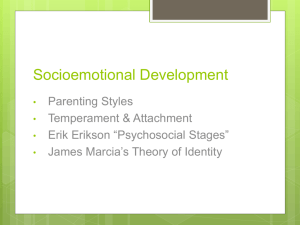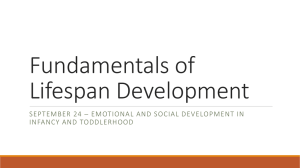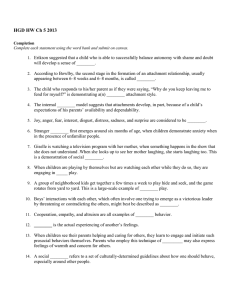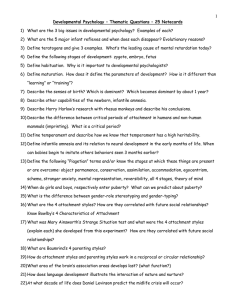February 3rd – Social and Personality Development
advertisement
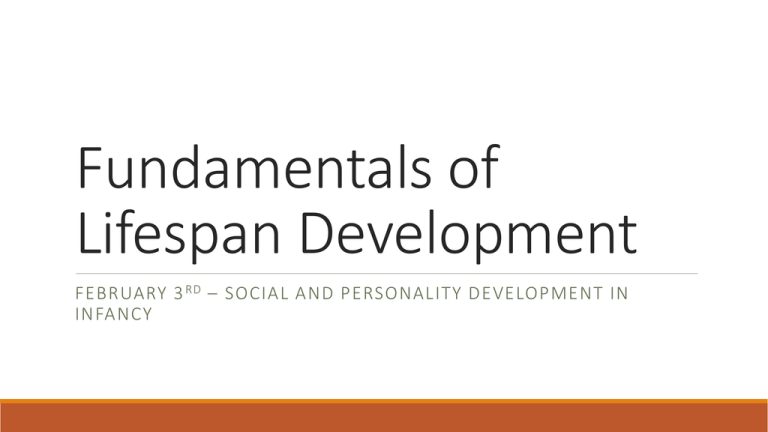
Fundamentals of Lifespan Development FEBRUARY 3 RD – SOCIAL AND PERSONALITY DEVELOPMENT IN INFANCY Video Erik Erikson Harry Harlow Mary Ainsworth John Bowlby – 5:40 Erikson’s Psychosocial Stages Erikson’s Psychosocial Stages Bowlby’s Ethological Theory of Attachment Non-focused orienting and signaling (Birth to 3 months) – Babies want attention from anyone whom they come in contact. Grasping, crying, smiling, gazing, etc.. Focus on one or more figures (3 to 6 months) – Direct attention from less people. Secure base behavior (6 – 24 months) – Proximity seeking from ‘safe bases’. Primary caregiver (or multiple ‘primary care givers”). Internal model (24 months +) – Reciprocal exchanges in developing bonds with caregivers. Key words Attachment – Emotional bond Synchrony – Mutual pattern of attachment behaviours Stranger anxiety – Afraid of strangers Separation anxiety – Don’t want to be away from primary caregiver Social referencing – Looking for cues by their attachment figures to help them figure out what to do in situations Development of Basic Emotions Ainsworth Attachment Styles Strange Situation Paradigm Secure attachment (60%) Avoidant attachment (15%) Resistant attachment (10%) Disorganized/disoriented attachment (15%) Factors that affect attachment ◦ Early emotional availability of consistent caregiver ◦ Contingent responsiveness ◦ Marital status & socioeconomic status & mental health of primary caregivers ◦ Infant characteristics ◦ Parents’ internal working models Multiple Attachments to: Cultural Variations ◦ ◦ ◦ ◦ ◦ Mothers Fathers Siblings Grandparents Professional caregivers Dimensions of Temperament Thomas & Chess (1977) ◦ Easy child (40%) ◦ Difficult child (10%) ◦ Slow to warm up (15%) ◦ Not in a category (35%) New Theories ◦ Activity level ◦ Approach/positive emotionally/sociability ◦ Inhibition and anxiety ◦ Negative emotionality/irritability/anger ◦ Effortful control/task persistence Origins: Heredity, neurological process, environment, goodness of fit The Self Self concept ◦ Internal model ◦ Object permanence ◦ Daily interaction with objects (goal directed behavior) Subjective self Separate from others Interaction with the environment (assimilation & accommodation) Objective self Awareness of self as a separate unique individual (defined through various categories) Self-Development Self-categorization (2nd year) – Develops along with language Self-control ◦ inhibit impulses ◦ manage negative emotions ◦ behave in socially acceptable ways Self-control depends on: ◦ awareness of self as separate, autonomous being ◦ confidence in directing own actions ◦ memory for caregiver’s directives Discussion What would your parents say about your temperament as an infant? When you were young, what was your attachment style with your parents? Secure, ambivalent, avoidant, or disorganized? What factors may have contributed to your attachment style?
